A Log Cabin is a great investment – very cost-effective, quick to build, easy to heat and environmentally friendly (what other building construction type has a lower carbon footprint!). And, at TimberLiving we have such a wide range of cabins, from small one-bedroomed to BIG three-bedroom log cabins, so you can be sure you will get exactly what you’re looking for. And they look SO good once they’re built!
You may be considering the purchase of a log cabin but someone has put you off by highlighting some of the following myths. But don’t be put off – maintenance is a lot easier than you might think.
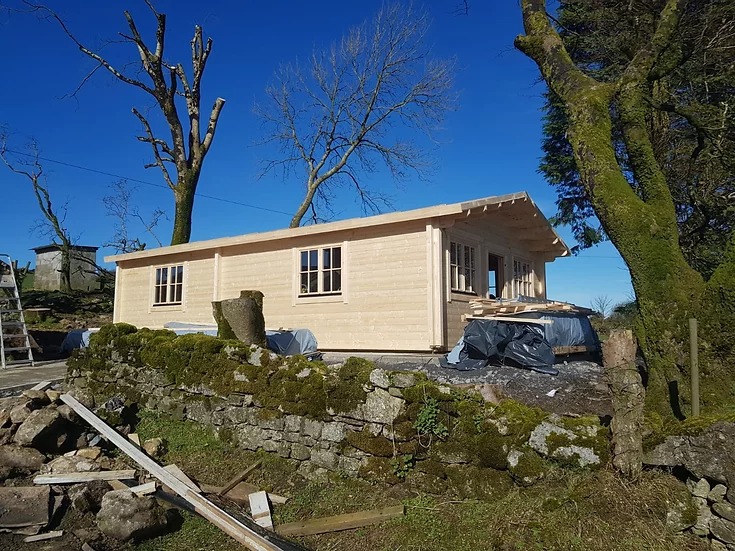
Beautiful, low-maintenance Log Cabin Exterior
Log cabin maintenance often gets talked about as a potential drawback compared to building a house from other materials. You will be surprised to find however that on balance, a log home will cost you a lot less in the long run. Wood is a remarkable material, and once it is treated well, it will last a lifetime. (They build boats out of wood, after all, and have done so for millennia. As long as the wood is treated properly, it will last and last.) Most of the ill-informed myths you hear about log cabin maintenance stem from stories where cabins have been badly built, badly treated or poorly maintained. Any of the following myths are as much down to people not looking after their wood properly as to anything bad about building a timber house.
Myth 1. Prepare yourself for a lot of maintenance work
If you build your house and follow the recommendations of any of our staff at Timber Living Log Cabins, then you can reduce any maintenance potential issues significantly. The exterior needs to be treated only every three to four years – just like any house!
Myth 2. Log homes attract mould
This myth is actually true in some cases. We have seen cabins with a lot of extensive mould, and you will definitely get mould in your log cabin if it is incorrectly built. Your log cabin needs a cavity wall and some decent insulation. (We offer 100mm cavities, filled with insulation, as standard.)
Do not buy a single wall (75mm or 90mm thickness, as offered by some companies) cabin, unless you intend to insulate either the interior or exterior of the wall. The reason these single-wall cabins get mould is due to the warm moist air inside the cabin coming in contact with the cold surface of the wall. The dampness settles on the wall and mould appears. Oftentimes, the mould only appears behind presses and other unseen spots, because the heating in the room warms the exposed walls, but the walls behind the presses remain cold, leading to mould forming.
Any house type can suffer from mould. The important thing is to keep your log home insulated and double-glazed while allowing air to circulate. Wood also happens to be naturally good at allowing air to circulate.
How do you maintain a log cabin?
The main element of Log cabin maintenance is the exterior “painting”. We talk about painting a log cabin, but actually, you need to use a solvent-based stain rather than paint on your log cabin. Paint is a sealant, and your log cabin timber needs to be able to breathe. Moisture is not good for wood, and painting a log cabin seals the surface and will trap any moisture inside your cabin. There are a number of different wood stain suppliers available.
Best exterior paint for log cabins
We highly recommend SIKKENS wood stains as the best exterior paint for log cabins. This is a Dutch product which is widely used and highly recommended. Their HLS Plus product is a solvent-based, highly translucent wood stain. Its low viscosity makes it ideal for use on bare timber.
Dulux is the distributor, and you should be able to get it in your local hardware store. Normally, they have a basic range available in-store, so ask behind the counter for the colour charts. They will probably have to order directly from the suppliers. They also recommend two coats of standard preservatives before any work is done, especially concentrating on any wood ends, where a lot of preservatives will be soaked in.
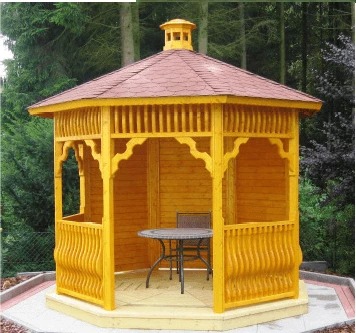
Treat your Log Cabin Exterior with Sikkens
A wide range of log cabin wood stain colours are available. The only problem with Sikkens is that they don’t offer cheap trial pots, so you will have to invest in a few of their smallest tins. But be sure that you do trials – the colour charts are not very accurate. Because the stain is translucent, the type/colour of your wood will affect the final colour of the building.
How often should I “paint” my log cabin?
First of all, you don’t paint your log cabin, you stain it. (See above). Depending on the location of the log cabin, and exposure to the elements (sunlight as well as harsher wind and rain) you will need to re-stain your log cabin every three or four years. Sikkens has a specific stain for UV protection, which can be used as one of the three coats required. You should apply this if your cabin is located in a sunny spot. Read their spec sheets carefully!
How Long will a Log cabin Last?
A good question! And the best answer we can give is that a log cabin will last a lifetime, as long as the wood is treated well. The picture below is of a 500-year-old timber-built house we saw in Brittany when on holidays over there.
We build our cabins so that they overhang the concrete base by 10mm all around. We also run a throat-ed rain sill all around the bottom of the cabin. In this way, water will never pool under the cabin. This is a crucial detail, and the most important one in ensuring the longevity of our log cabins.
Log Cabin Maintenance Checklist
What are the main things to check when maintaining your log cabin?
-
Stain the exterior every 3-4 years
-
Check that all walls are free from contact with soil/stones etc.
-
Ensure gutters are free from leaves/blockages and operating well.
-
Maintain mastic seals around windows.
Best exterior paint for log cabins
We highly recommend SIKKENS wood stains as the best exterior paint for log cabins. This is a Dutch product which is widely used and highly recommended. Their HLS Plus product is a solvent-based, highly translucent wood stain. Its low viscosity makes it ideal for use on bare timber.
Sikkens Cetol HLS Plus is a low-build satin basecoat and wood stain for most exterior woods. It can be used as both a basecoat and a finishing coat depending on the project you are doing.
https://www.wood-finishes-direct.com/…
It is resistant to UV, surface mould and algae, peeling and cracking. The wood grain remains visible and it can be over-coated with Sikkens Cetol Filter 7 Plus.
It is an ideal product to use on softwood, hardwood, plywood, block board and particle board, such as cladding, fascias, architraves, timber frames, fences, and sheds.
Preparation
Wood to be treated with Sikkens Cetol HLS Plus should be clean, dry and free from surface dirt, debris and surface coatings such as paint or varnish.
Degrease any exposed bare timber surface by wiping with a cloth dampened in a suitable solvent.
The use of ‘knotting agents’ is not recommended with translucent finishes as they are not always fully effective in sealing in resin, the presence of knots is often highlighted and adhesion of coatings can be impaired.
When filling, be sure to use fillers specifically designed for use with timber. General or all-purpose fillers may not be suitable.
Applying Sikkens HLS Plus
Always do a test area before starting any project to test adhesion and final finish. Follow the manufacturer’s instructions on the tin at all times.
Ensure that Sikkens Cetol HLS Plus is stirred thoroughly before and periodically during application use to ensure a consistent finish.
Application temperature should not be below or exceed 5 – 30℃ and a relative humidity of 85%.
New timber
Where a superficial application of wood preservative to softwood and hardwood is deemed necessary, ensure that the wood preserver used does not contain any wax and has fully dried before applying Cetol HLS plus.
Note: Sikkens Cetol HLS Plus cannot be used on substrates which have had water-repellent wood preservatives or pre-treatments applied i.e. products that contain wax, oil or silicon.
Where possible, the first coat should be applied all around prior to fixing. Only use non-ferrous screws, nails and fixings. Denib using a fine-grade nylon abrasive pad or a fine-grade (P240 or finer) wet or dry silicon carbide abrasive paper, in the direction of the grain. Do not break through the surface coating. Take care to ensure that all sanding/denibbing dust has been removed from the surface prior to applying additional coats.
Note: Where any damage or deterioration has occurred as a result of exposure to the factory coating for longer than 3 months, affected areas should be thoroughly sanded back to a sound substrate.
Damaged or decayed timber
All damaged or decayed timber must be removed and replaced, cutting at least 25mm into sound timber. When splicing in new sections of timber, consideration should be given to the use of timber species whose natural durability is sufficient. Brush and apply two coats of a suitable wax-free wood preserver. Ensure timbers are thoroughly treated, especially any end grain sections, and are fully dry before splicing in. Secure with non-ferrous fixings and fill all voids surrounding the spliced-in area with a suitable exterior wood filler.
Apply 2 finishing coats of Sikkens HLS Plus. For best results, it is necessary to keep the interval between applications of these coats limited, not exceeding 1 month.
Depending on the condition of the finish, clean, degrease and sand thoroughly. Repair defects with Cetol HLS Plus in the appropriate colour and apply one full coat of Cetol HLS Plus, overall. Transparency Maintain the translucent appearance of Cetol HLS plus over a longer period. It is recommended to use Cetol Clearcoat LB or alternatively use lighter colours, 077 or 006 for maintenance applications.
Product Coverage
Coverage greatly depends on the wood species under treatment, the surface condition, the method of application and conditions during application. Under normal conditions, coverage will be between 10 to 14 square meters, On rough-sawn timber the coverage is significantly lower (e.g. 7 – 10 square meters).
Equipment Cleaning
Application brushes and equipment should be cleaned immediately after use with White Spirit.
Storage
Keep this product tightly sealed at all times and stored/transported in an upright position. Store in a dry place at temperatures between 5 – 30℃. The shelf life for this product is a minimum of 24 months in original and unopened packaging.
Drying Time
Sikkens HLS Plus is touch dry after 4 to 6 hours and recoat between 18 to 24 hours. Air temperature and humidity may affect drying times.
The only problem with Sikkens is that they don’t offer cheap trial pots, so you will have to invest in a few of their smallest tins. But be sure that you do trials – the colour charts are not very accurate. Because the stain is translucent, the type/colour of your wood will affect the final colour of the building.

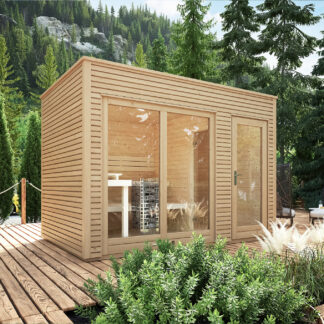
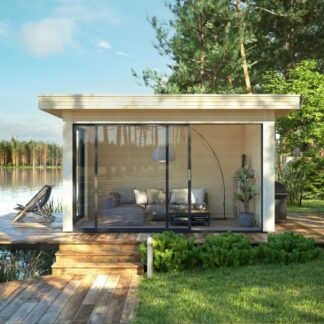
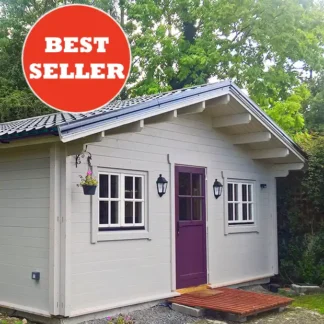
Thank you for sharing this article. I could say that I was able to gain information in this article. Very informative and reliable, great work.